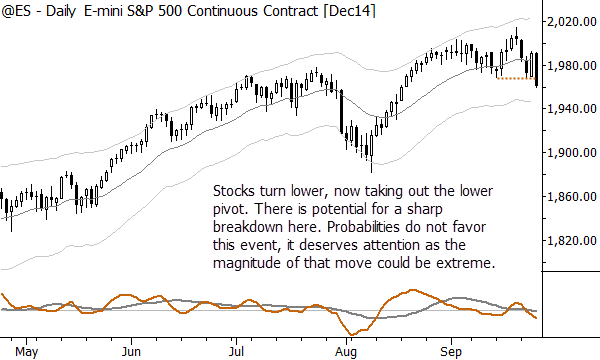The one thing I am paying attention to in the S&P 500 right now
We are awash in opinion and speculation. Every trader is writing blog posts or tweets about why the market will go up or down, and citing any number of factors. To my way of thinking, simple is better. There is only one thing that matters, and that is whether the market will absorb this recent bout of selling pressure, as it has every selloff for many years, or whether this time will be different and stocks will develop serious downward momentum. Until I see something decisively change, I will assume that this is a market that is basically set to hurt the largest number of traders (i.e., most overconfident, and who's overconfident after today? Short-term bears, beware.), and that any market move is highly suspect at best.
Personally, I work best when I eliminate the noise and speculation, and focus on what is clearly in front of me on the price chart. I wrote a few words on that perspective in my research report from last weekend. Pundits tend to do a lot of hand waving and say "technical factors" are driving the market, these technical factors are very rarely explained. In that report, I explained what I thought, and still think, to be the most important technical factor in the stock market right now, and it's pretty simple:
Technical factors, reflecting sentiment and psychology are the critical elements of market behavior over the next several weeks.
- Any large downward shock should be quickly absorbed. We want to see that buyers still have an interest in stocks and that selling does not lead to further selling.
- US Stocks have established some degree of leadership and, ideally, we would like to see that continue. Large-scale weakness in US stocks could signal a significant (6+ month) period of global weakness.
- US indexes are holding at new highs. Though a pullback or even a sharp selloff is possible, it should be limited in time (<2 weeks) and scope. Again, selling should not lead to further selling.
- Bearish patterns in Europe should fail. (Again, selling should not lead to further selling—this is the recurring theme.)
- We see no moves in rates, currencies, or any commodities that could, at this point, have a significant impact on global stock prices.
It really is that simple: downward momentum should be relatively quickly absorbed and declines should not lead to further selling. Some patience is required, as these patterns unfold over several days, but that, to me, is the best guiding principle we have right now.




